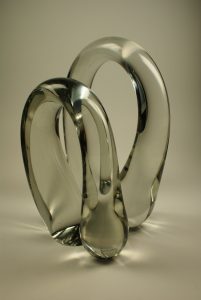STUDIOGLAS-KABINETT: Harvey K. Littleton – Deutsch/German

Studioglas steht für eine historische Bewegung, die ihren Höhepunkt Ende der 1950er bis in die 1980er Jahre hatte. Studioglas meint eine künstlerische und somit zweck- und funktionsfreie Bearbeitung des Glases. Ein entscheidender Schritt hierfür war die Erfindung des Studioglasofens – eines kleinen Glasschmelzofens, in dem 50 bis 80 Kilogramm Glas geschmolzen werden können. Das ist genau die Menge, die man an einem Tag verarbeiten kann. Nun war es Künstlern möglich, frei und unabhängig vom Hüttenbetrieb zu arbeiten – ein Vorteil vor allem für Frauen, denen die Arbeit am Hüttenofen nicht erlaubt war. Der Studioglasofen schuf die Voraussetzung dafür, dass in kurzer Folge an Kunstakademien und Kunsthochschulen, vor allem in den USA, Glasklassen eingerichtet wurden und Künstler in ihren Werkstätten eigenhändig arbeiten konnten.
Miterfinder des Studioofens war der Amerikaner Harvey K. Littleton. Mit seinem Ofen und seinen Arbeiten auch an deutschen Kunstakademien und Symposien trug er entscheidend zur Verbreitung und internationalen Etablierung der Studioglasbewegung bei. Vor allem auch deshalb, weil er das Medium Glas als Gestaltungsmittel in die Kunst einführte. Dabei kommt der Form eine völlig neue Bedeutung zu: Sie wird zur Glasskulptur.
Littletons „Loops“ oder „Die Verbeugenden“ von 1974 zeigen die pure Freude am Charakter des Materials Glas. Die gebogenen Formen wirken wie aus der Tube gedrückte Farbmassen. Sie veranschaulichen nichts anderes als die Formbarkeit des Glases und deren Erstarrung mitten im Schaffens- und Fließprozess. Der Künstler hält einen Ausschnitt des Arbeitsprozesses, das Fließen von Glas, fest und macht ihn dadurch sichtbar.
STUDIO GLASS Cabinet: Harvey K. Littleton – English

Studio Glass Is the name given to a historical movement that reached its high point at the end of the 1950s and continued into the 1980s. Studio glass means a free artistic processing of glass that is not related to purpose or function. The invention of the studio glass furnace was a decisive step in this direction. It was a small glass furnace in which 50 to 80 kg of glass could be melted. This is the exact amount that one person can process in a day and it meant artists were free from and independent of glass foundries – an advantage for women especially, who were not allowed to work at a foundry furnace. The studio glass furnace enabled artists to work alone in their own workshops and set off a chain reaction that led to glass courses being offered at art academies and arts colleges in the USA especially.
An American called Harvey K. Littleton was the co-inventor of the studio glass furnace. This and his works meant he was instrumental in the international establishment and popularity of the studio glass movement, also at German art academies and Symposia. Above all though because he introduced the medium of glass to art as a design material, and the shaping of it took on a new meaning: it became glass sculpture.
Littleton’s „Loops“ or „the bowing,“ from 1974 demonstrate his pure joy in the character of glass. The curved forms look like paint that have been squeezed out of a tube and they illustrate nothing other than the malleability of glass and its solidification in the middle of the creative and flowing process.
The artist captures a section of the working process, the flowing of glass, and makes it visible.